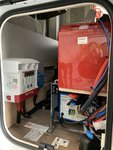xsilvergs
Free Member
- Messages
- 240
I've read similar things about the Sterling and also (I think) the Ring both getting hot and throttling back their charge significantly and it is a bit concerning.
I know on somne testing I did the Ablemail 30A unit ran continuously for 4 hours at full output (actually putting out 32A) with no issues and the Redarc 40A unit put out between 35A and 38A (fluctuated between that range) for slightly more than 4 hours.
What is interesting about that is neither the Ablemail OR the Redarc has ANY active cooling in the form of fans and are sealed units with no airflow within them. I guess a very clear difference in design approach? (I'll be doing a test on the Ablemail 60A B2B shortly and attaching a temperature sensor as well - the 30A unit hit 50C after 4 hours of full-on output)
How about a back-to-back test to compare the Sterling Power BB1260 and the Ablemail 60A B2B?




